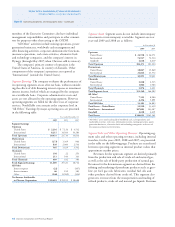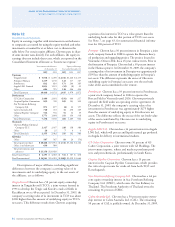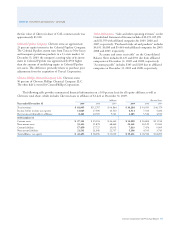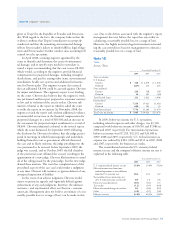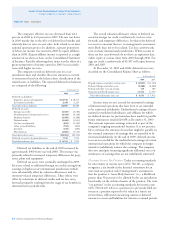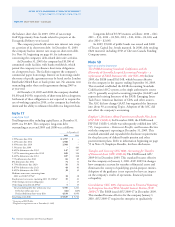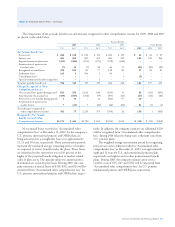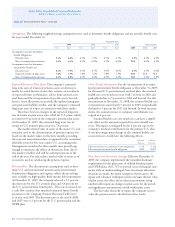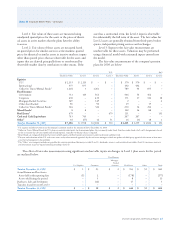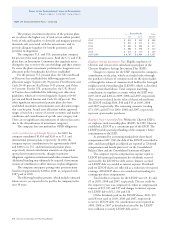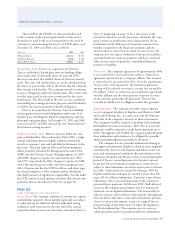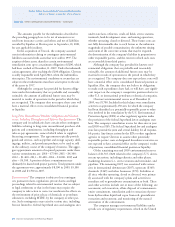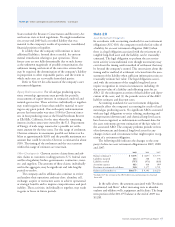Chevron 2009 Annual Report Download - page 59
Download and view the complete annual report
Please find page 59 of the 2009 Chevron annual report below. You can navigate through the pages in the report by either clicking on the pages listed below, or by using the keyword search tool below to find specific information within the annual report.
Chevron Corporation 2009 Annual Report 57
FS-PB
2009 2008 2007
Beginning balance at January 1 $ 2,118 $ 1,660 $ 1,239
Additions to capitalized exploratory
well costs pending the
determination of proved reserves 663 643 486
Reclassifications to wells, facilities
and equipment based on the
determination of proved reserves (174) (49) (23)
Capitalized exploratory well costs
charged to expense (172) (136) (42)
Ending balance at December 31 $ 2,435 $ 2,118 $ 1,660
The following table provides an aging of capitalized well
costs and the number of projects for which exploratory well
costs have been capitalized for a period greater than one year
since the completion of drilling.
At December 31
2009 2008 2007
Exploratory well costs capitalized
for a period of one year or less $ 564 $ 559 $ 449
Exploratory well costs capitalized
for a period greater than one year 1,871 1,559 1,211
Balance at December 31 $ 2,435 $ 2,118 $ 1,660
Number of projects with exploratory
well costs that have been capitalized
for a period greater than one year* 46 50 54
* Certain projects have multiple wells or fields or both.
Of the $1,871 of exploratory well costs capitalized for more
than one year at December 31, 2009, $1,143 (28 projects)
is related to projects that had drilling activities under way
or firmly planned for the near future. The $728 balance
is related to 18 projects in areas requiring a major capital
expenditure before production could begin and for which
additional drilling efforts were not under way or firmly
planned for the near future. Additional drilling was not
deemed necessary because the presence of hydrocarbons
had already been established, and other activities were in
process to enable a future decision on project development.
Note 18 New Accounting Standards – Continued
assess if it is the primary beneficiary of a variable-interest entity
(VIE), and, if so, the VIE must be consolidated. Adoption of
the standard is not expected to have a material impact on the
company’s results of operations, financial position or liquidity.
Extractive Industries – Oil and Gas (ASC 932), Oil and Gas
Reserve Estimation and Disclosures (ASU 2010-03) In January
2010, the FASB issued ASU 2010-03, which became effective
for the company on December 31, 2009. The standard
amends certain sections of ASC 932, Extractive Industries – Oil
and Gas, to align them with the requirements in the
Securities and Exchange Commission’s final rule, Modernization of
the Oil and Gas Reporting Requirements (the final rule). The
final rule was issued on December 31, 2008. Refer to Table
V – Reserve Quantity Information, beginning on page 76,
for additional information on the final rule and the impact
of adoption.
Note 19
Accounting for Suspended Exploratory Wells
Accounting standards for the costs of exploratory wells (ASC
932) provide that exploratory well costs continue to be capi-
talized after the completion of drilling when (a) the well has
found a sufficient quantity of reserves to justify completion
as a producing well and (b) the enterprise is making sufficient
progress assessing the reserves and the economic and operat-
ing viability of the project. If either condition is not met or
if an enterprise obtains information that raises substantial
doubt about the economic or operational viability of the proj-
ect, the exploratory well would be assumed to be impaired,
and its costs, net of any salvage value, would be charged
to expense. The accounting standards provide a number of
indicators that can assist an entity in demonstrating that suf-
ficient progress is being made in assessing the reserves and
economic viability of the project.
The following table indicates the changes to the com-
pany’s suspended exploratory well costs for the three years
ended December 31, 2009:



